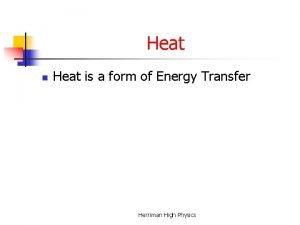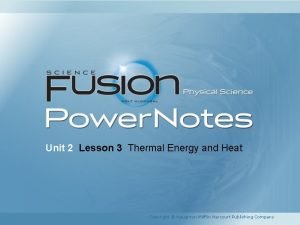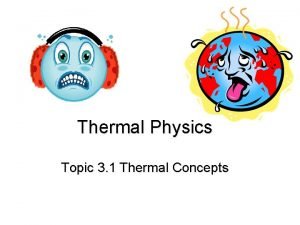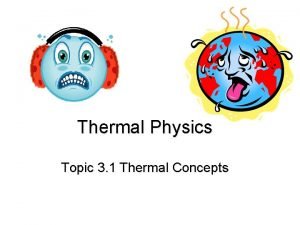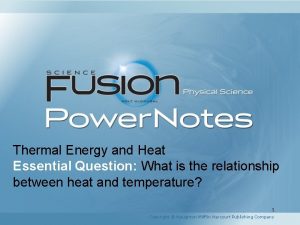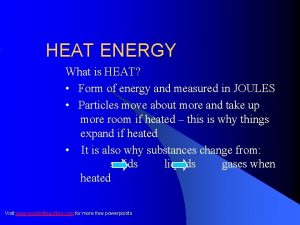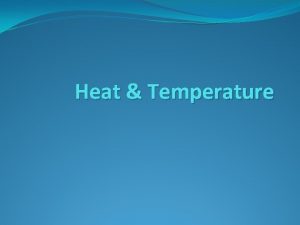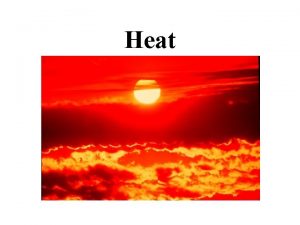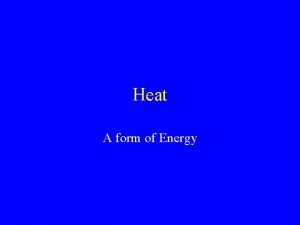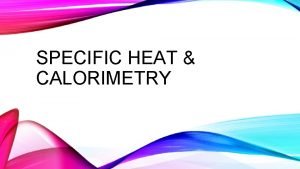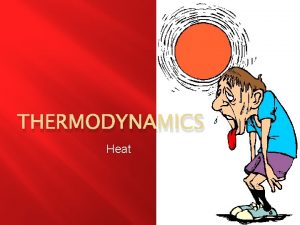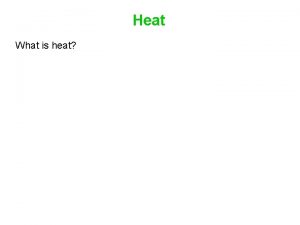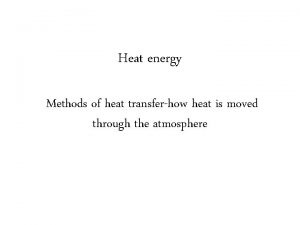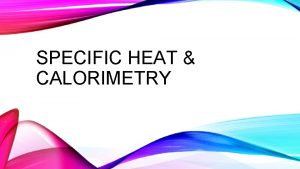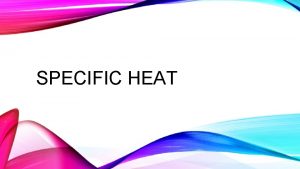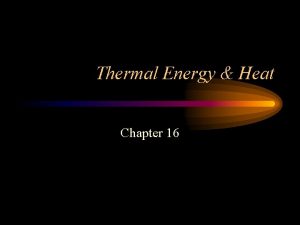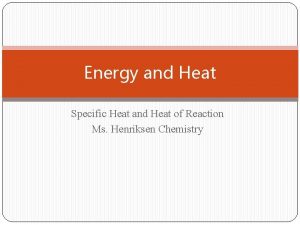HEAT ENERGY What is HEAT Form of energy


















- Slides: 18

HEAT ENERGY What is HEAT? • Form of energy and measured in JOULES • Particles move about more and take up more room if heated – this is why things expand if heated • It is also why substances change from: solids liquids gases when heated Visit www. worldofteaching. com for more free powerpoints

Heat and Temperature The temperature of an object tells us how HOT it is l Measured in degrees Celsius - °C l It is NOT the same as heat energy although the two quantities are related. e. g. a beaker of water at 60 °C is hotter than a bath of water at 40 °C BUT the bath contains more joules of heat energy l

Heating and Cooling l If an object has become hotter, it means that it has gained heat energy. l If an object cools down, it means it has lost energy

Heating and Cooling cont… l Heat energy always moves from: HOT object COOLER object e. g. Cup of water at 20 °C in a room at 30°C gains heat energy and heats up – its temperature rises Cup of water at 20 °C in a room at 10°C loses heat energy and cools down – its temperature will fall.

HEAT ENERGY • Energy transfer Conduction Convection Radiation

Conduction Heat is transferred through a material by being passed from one particle to the next l Particles at the warm end move faster and this then causes the next particles to move faster and so on. l In this way heat in an object travels from: l the HOT end the cold end

Conduction cont… Occurs by the particles hitting each other and so energy is transferred. l Can happen in solids, liquids and gases, l Happens best in solids-particles very close together l Conduction does not occur very quickly in liquids or gases l

Conductors Materials that conduct heat quickly are called conductors l All metals are good conductors of heat l Copper is a very good conductor of heat l Pans for cooking are usually made with a copper or aluminium bottom and plastic handles l

Insulators/poor conductors l l l Materials that conduct heat slowly or poorly are called insulators Glass, wood, plastic and rubber are poor conductors (good insulators) Nearly all liquids including water are poor conductors (good insulators) Gases, including air are poor conductors, e. g. , wool feels warm because it traps a lot of air A fridge has insulation material round it to keep it cold – reduces amount of heat conducted to inside from the warmer room

Convection Takes place in material where particles can move around inside the material, i. e. liquid or gas l The heat is carried by the particles themselves moving Convection currents l Occur because an area with warm particles expands and becomes less dense than the cooler areas nearby. The warm area rises. Cooler particles fall into the space left by the warm particles and convection current is set up l

Convection Currents l Hot liquids and gases expand rise while the cooler liquid or gas falls 2. Goes across 3. Then down 1. Hot air rises 4. And across

Convection cont… The sun cause large convection currents - WINDS l During daytime the land warms up more than the sea. The warm air rises over the land cool air falls over the sea. So we feel a sea breeze. l Rising convection currents can be uses by glider pilots to keep their planes in the air and by birds to stay aloft. l

Radiation Transfer of heat directly form the source to the object by a wave, travelling as rays. l Heat radiation is also known as INFRA-RED RADIATION l All objects that are hotter than their surroundings give out heat as infra-red radiation l Heat transfer by radiation does not need particles to occur and is the only way energy can be transferred across empty space l

Emitters Hotter objects emit (give out) heat l Different surfaces emit heat at different speeds l A dull black surfaces loses energy more quickly – it is a good radiator l A bright shiny or white surface is a poor radiator l Marathon runners need to keep warm at the end of races, covering in shiny blankets reduces radiation and therefore heat loss. l

Emitters of heat Bright shiny can Poor radiator Dull black can Good Radiator

Absorbers l. Cooler objects absorb (take in) heat l. Substances l. Dull, absorb heat at different speeds black surfaces absorb heat quickly l. Bright, shiny surfaces absorb heat slowly l. In hot countries, people wear bright white clothes and paint their houses white to reduce absorption of energy from the sun. l. Petrol storage tanks sprayed silver to reflect sun’s rays

Absorbers Shiny, bright can Poor absorber Dull black can Good absorber

Key Words Temperature Cold Insulator Radiation Transfer Heat Conduction Emitter Convection Conductor Absorber
 Heat form
Heat form Heat is a form of energy
Heat is a form of energy How are thermal energy and temperature different
How are thermal energy and temperature different Present continuous interrogative form
Present continuous interrogative form Wind energy is an indirect form of
Wind energy is an indirect form of Energy energy transfer and general energy analysis
Energy energy transfer and general energy analysis Energy energy transfer and general energy analysis
Energy energy transfer and general energy analysis Thermal capacity
Thermal capacity Latent heat release
Latent heat release Moist cooking methods
Moist cooking methods Heat loss form factor calculation
Heat loss form factor calculation Heat flowing out of earth as it cools is one form of
Heat flowing out of earth as it cools is one form of Heat is a form of
Heat is a form of What is the difference between thermal energy and heat?
What is the difference between thermal energy and heat? Heat energy transfer
Heat energy transfer Difference between heat and thermal energy
Difference between heat and thermal energy Difference between heat and thermal energy
Difference between heat and thermal energy Thermal energy vs heat
Thermal energy vs heat Difference between heat and thermal energy
Difference between heat and thermal energy

